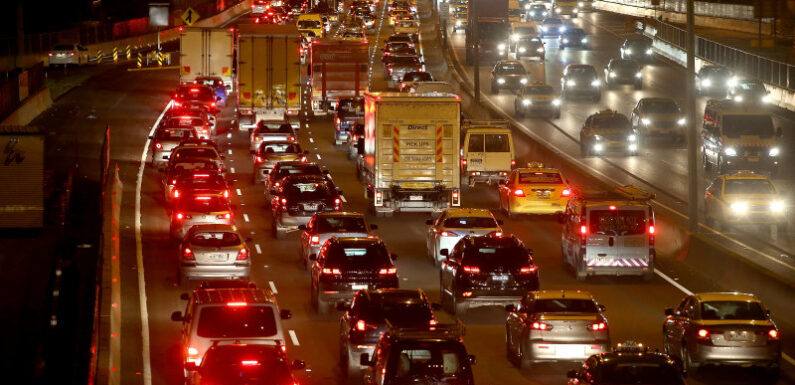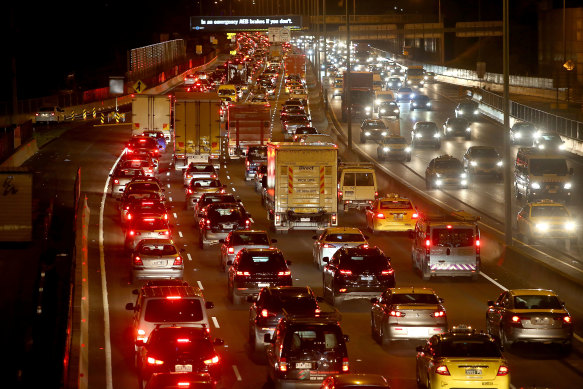
Save articles for later
Add articles to your saved list and come back to them any time.
Farmers and motorists will need to do some heavy lifting on cutting greenhouse emissions for Australia to meet its legally binding climate targets, exposing the federal government to the risk of fiery debates over potentially controversial policies ahead of the next election.
The latest greenhouse emissions data released by the government revealed pollution from transport and agriculture rose during the past three months, putting those sectors in the sights for reduction targets.
Emissions from transport and agriculture are rising, posing a challenge to Australia’s climate targets. Credit: Pat Scala
Australia’s largest source of emissions, electricity, fell 3.9 per cent in the quarter to June, but agriculture rose 3.2 per cent while transport’s greenhouse footprint increased by 6.4 per cent.
While emissions reduction in electricity is largely being delivered by swapping ageing coal-fired power plants for cheaper renewables, cleaning up transport and agriculture will require motorists and farmers to invest in technology like electric vehicles or regenerative farming techniques that may require significant upfront capital and be politically unpopular.
The Albanese government has committed to reach net zero by 2050 and cut emissions by 43 per cent by 2030 and plans to deliver the bulk of emissions cuts over the next decade by more than doubling the amount of renewable energy in the electricity grid – to 82 per cent by 2030 – and requiring the nation’s 215 biggest carbon emitters to cut their pollution by about 5 per cent each year until 2030 under the safeguard mechanism.
But the Paris Agreement requires Australia to declare by 2025 a more ambitious climate target for 2035 and experts said new policies are needed to cut the greenhouse contributions from agriculture, which generates 17.5 per cent of Australia’s emissions, and from transport, which generates 20.9 per cent of the national total.
Grattan Institute climate and energy expert Alison Reeve said the challenges of cutting emissions in transport and agriculture means the government has no time to lose.
“This doesn’t get any easier, the longer you leave it,” Reeve said.
“The sectors [energy and heavy industry] that have policy in them at the moment are ones where you have a small number of large sources of emission.
“When you get into transport and agriculture you’re talking about a large number of small sources – with millions of cows, millions of sheep, millions of cars – which means that your pattern of change is a lot slower because you have to do lots of very small individual things.
“You can’t chop it off in, in big chunks like you can with closing a coal-fired power station.”
The federal government has committed to imposing a fuel efficiency standard for vehicle manufacturers aimed at encouraging them to sell more electric vehicles but is yet to finalise the final design.
“You need that standard to push hard enough such that all new cars are zero emissions by 2035 because we keep our cars for 15 to 20 years so the car that you buy in 2035 is potentially still on the road in 2049,” Reeve said.
Australian Farm Institute general manager Katie McRobert said Australian farmers are leading the global pack on emissions reduction and while further gains were still possible, they would be increasingly challenging.
“Australian farmers have actually done a lot of heavy lifting, with a great deal of work on practice change over the past three decades,” McRobert said.
She pointed to the example of farmers in the United States now being paid to change their cropping practices to be more effective in storing carbon in soils, when Australian farmers moved to conservation tillage 20 years ago for productivity gains.
McRobert said the “low-hanging fruit for agriculture has been plucked” and “the gains now are going to be really hard”.
Wei Sue, head of strategy at the Climateworks Centre think tank said while there were some relatively straightforward opportunities to cut emissions in agriculture, like swapping diesel equipment for new electric machines, other policies will be more challenging and affect consumers as well as producers.
“There are policy considerations that require more coordination – for example, reducing food loss and waste could actually have a big impact on things like reducing beef or cattle emissions and also fertiliser use,” Sue said.
“Put simply if we reduce the amount of food waste that we generate, we therefore reduce the amount of food we need to produce, to feed the same population.”
Australian Industry Group chief executive Innes Willox said warned against forcing the heavy industrial companies he represents from doing all the heavy lifting.
“A much wider swathe of the economy will need to make investments and change practices to hit more challenging emissions numbers for 2035,” Willox said in response to government’s plan to work with the private sector to drive emissions reduction.
Climate Change and Energy Minister Chris Bowen announced in June that government would work with industry to produce, for the first time, plans to cut emissions from industries considered more challenging than the energy sector – but has stressed he is not contemplating emissions reduction targets for sectors of the economy.
Cut through the noise of federal politics with news, views and expert analysis from Jacqueline Maley. Subscribers can sign up to our weekly Inside Politics newsletter here.
Most Viewed in Politics
From our partners
Source: Read Full Article
